A Cross-Institution Information-Sharing Scheme Based on a Consortium Blockchain
Abstract
:1. Introduction
- A cross-institution information-sharing scheme based on consortium blockchain is proposed, which enables the sensitive data of one institution privacy shared with others;
- A dynamic and adaptive PBFT consensus protocol is proposed. The security of the blockchain network has been enhanced by the utilization of a reputation mechanism to remove malicious nodes.
2. The Proposed Cross-Institution Information-Sharing Network Based on a Consortium Blockchain
2.1. Information Storage
2.2. Information Sharing
- Node B stores the information hash and metadata on the blockchain (① in Figure 1);
- Node A initiates a request to Node B (② in Figure 1);
- Node B can verify the content of sensitive data without needing access to the specific details of the sensitive information. After successful verification, Node B records the access as a transaction on the blockchain network, awaiting consensus (⑤ in Figure 1);
- Nodes within the cross-institution information-sharing network collectively participate in reaching consensus on the order and content of transactions (⑥ in Figure 1), subsequently recording the transactions on the blockchain. The consensus protocol used by nodes to achieve consensus on transactions is the DA-PBFT consensus protocol proposed in this paper. We will provide a detailed introduction to this consensus protocol in Section 3.
3. Dynamic and Adaptive PBFT Consensus Protocol
3.1. The PBFT Consensus Protocol
3.2. The Proposed Dynamic and Adaptive PBFT Consensus Protocol
3.2.1. The Proposed Adaptive Consensus
3.2.2. Nodes Join the Blockchain Dynamically
- The preprocessing requests phase.Assuming a new node i sends a request to join the blockchain (① in Figure 5), the preprocessing is applied as follows:
- (a)
- checks the identity information of node i. If the verification is successful, it sends a message < < JOIN-pre, v’, s’, d’>, m > to the replica nodes of the observation group (② in Figure 5). Otherwise, it discards the request message;
- (b)
- Upon receiving the JOIN-pre message, the replica nodes of the observation group validate the message by verifying the correctness of the signature and comparing the calculated hash of the message with its digest. If the validation is successful, the replica node sends an <JOIN-reply, v’, s’, , D(m) > message to (③ in Figure 5). Otherwise, it discards the message;
- (c)
- When receives JOIN-reply messages with valid signatures from f + 1 different replica nodes, it sends the preprocessed result as the consensus request message <REQUEST, o, t, c > to the nodes of the consensus group (④ in Figure 5). This ensures that the result is valid, as at most f replicas can be faulty.
- The consensus phase.The nodes in the consensus group only perform a two-phase consensus process, consisting of the pre-preparing and preparing phases. When the consensus group primary node receives a request message, it initiates a two-phase protocol, automatically broadcasting the request to the replica nodes of the consensus group:
- (a)
- assigns a sequence number s to the request and multicasts < < PRE-PREPARE, v, s, d > , m> to the replica nodes of the consensus group (⑤ in Figure 5);
- (b)
- Upon receiving the pre-preparing message, the replica nodes of the consensus group perform the following verification operations:
- Check the signatures of the request and pre-preparing messages, and verify if d is the digest of m;
- Check if it is in view v;
- Check if it has not received a pre-preparing message with a different digest for the same v and s.
If the replica nodes of the consensus group accept the pre-preparing message, it multicasts a <PREPARE, v, n, d, j > message to all other replica nodes of the consensus group (⑥ in Figure 5); otherwise, the replica node j does nothing; - (c)
- The replica nodes of the consensus group accept preparing messages if the signatures are correct and their view number matches the current view v of the replica bodes. When a replica node of the consensus group receives preparing messages from different replica nodes with high reputation values, broadcasts the message <JOIN, i, ip> to all nodes in the blockchain (⑦ in Figure 5);
- (d)
- The nodes in the blockchain synchronize messages and add the information of node i to the locally maintained NL table. Then, they send a reply message <REPLY, v, t, j, r, C, NL> to the new node i (⑧ in Figure 5);
- (e)
- When the new node i receives f + 1 reply messages from different nodes, it successfully joins the blockchain.
3.2.3. Nodes Exits the Blockchain Dynamically
- Voluntary exit.A voluntary exiting from blockchain network is realized through two stages, preprocessing and consensus, as shown in Figure 6.
- (a)
- The preprocessing requests phase.In the blockchain network, node i initiates exit request<EXIT-req, i, ip, pk, NL> to performs a preprocessing (① in Figure 6). The detailed process is as follows:
- Receiving the EXIT-req request, first checks the node’s view number and other information. Then, sends the < < EXIT-pre, v’, s’, d’>, m > message to the observing group’s replica nodes (② in Figure 6);
- Receiving the EXIT-pre message, the observing group’s replica node verifies the message by checking the correctness of the signature and comparing the message’s hash with its digest. If the verification passes, the replica node sends <EXIT-reply,> to (③ in Figure 6);
- After receiving f + 1 valid signatures of EXIT-reply messages from different replica nodes, includes the preprocessing node as part of the consensus group’s request message <REQUEST, o, t, c > , which is then sent to the nodes of the consensus group (④ in Figure 6).
- (b)
- The consensus phase.Due to the introduction of a reputation model, the nodes in the consensus group can perform a two-phase consensus process, consisting of the pre-preparing and preparing phases. The complete process of consensus among the nodes in the consensus group is as follows:
- Node i in the blockchain first send an exit request <REQUEST, o, t, c > (④ in Figure 6);
- When receives request message, it initiates a two-phase protocol to atomically broadcast the request to the replica nodes of the consensus group;
- assigns a sequence number s to the request and multicasts < < PRE-PREPARE, v, s, d > , m> to the replica nodes of the consensus group (⑤ in Figure 6);
- Receiving the pre-preparing message, the replica nodes of the consensus group performs verification operations. If the replica nodes of the consensus group accepts the pre-prepare message, it multicasts a <PREPARE, v, n, d, j > message to all other replica nodes of the consensus group; otherwise, the replica node j does nothing (⑥ in Figure 6);
- The replica nodes of the consensus group accept preparing messages if the signatures are correct and their view number matches the current view v of the replica bodes. When a replica node of the consensus group receives prepare messages from different replica nodes with high reputation values, broadcasts the message <EXIT, i, ip> to all nodes in the blockchain (⑦ in Figure 6);
- Nodes in the blockchain send a reply message <REPLY, v, t, j, r>, and remove the information of node i from the locally maintained NL table (⑧ in Figure 6);
- When node i receives reply messages from different nodes, node i successfully exits the blockchain. Otherwise, node i will continue to perform tasks in the blockchain network.
- Forced exit.When the reputation value of node i is less than a special threshold for t consecutive rounds, the process of forced node exit from the blockchain is as follows:
- (a)
- The preprocessing requests phase.The primary node of consensus group detects that the reputation value of node i in the blockchain has remained below a specific threshold for t consecutive rounds. can directly issue a request <REQUEST, i, ip, pk, NL> to force node i to exit the blockchain;
- (b)
- The consensus phase.This phase aligns with the consensus stage of node voluntary exiting from the blockchain. Within the consensus group, nodes adaptively execute a three-stage or two-stage consensus based on the number of nodes with higher reputation value.
4. Performance Analysis of Cross-Institution Information-Sharing Network
4.1. Security Analysis
4.2. Communication Complexity Analysis
- In the JOIN-req phase, node i sends n messages;
- In the JOIN-pre phase, sends messages;
- In the JOIN-reply phase, observation group replica nodes send reply messages to , then the communication times are .
- In the REQUEST phase, sends a request message to nodes in the consensus group, resulting in a communication time of ;
- In the PRE-PREPARE phase, sends a pre-prepare message to the consensus group’s replica nodes, resulting in a communication time of ;
- In the PREPARE phase, consensus nodes multicast prepare messages, resulting in a communication time of ;
- In the JOIN phase, broadcasts a message to all nodes in the blockchain, resulting in a communication time of n;
- In the REPLY phase, all nodes in the blockchain reply to node i, resulting in a communication time of n.
5. Conclusions
Author Contributions
Funding
Data Availability Statement
Conflicts of Interest
References
- Nakamoto, S. Bitcoin: A Peer-to-Peer Electronic Cash System. 2008. Available online: https://bitcoin.org/en/bitcoin-paper (accessed on 27 September 2023).
- Chen, Z.; Zhu, Y. Personal archive service system using blockchain technology: Case study, promising and challenging. In Proceedings of the 2017 IEEE International Conference on AI & Mobile Services (AIMS), Honolulu, HI, USA, 25–30 June 2017; pp. 93–99. [Google Scholar]
- Kamišalić, A.; Turkanović, M.; Mrdović, S.; Heričko, M. A preliminary review of blockchain-based solutions in higher education. In Proceedings of the Learning Technology for Education Challenges: 8th International Workshop, LTEC 2019, Zamora, Spain, 15–18 July 2019; pp. 114–124. [Google Scholar]
- Lizcano, D.; Lara, J.A.; White, B.; Aljawarneh, S. Blockchain-based approach to create a model of trust in open and ubiquitous higher education. J. Comput. High. Educ. 2020, 32, 109–134. [Google Scholar] [CrossRef]
- Leng, K.; Bi, Y.; Jing, L.; Fu, H.C.; Van Nieuwenhuyse, I. Research on agricultural supply chain system with double chain architecture based on blockchain technology. Future Gener. Comput. Syst. 2018, 86, 641–649. [Google Scholar] [CrossRef]
- Saha, S.; Chattaraj, D.; Bera, B.; Kumar Das, A. Consortium blockchain-enabled access control mechanism in edge computing based generic Internet of Things environment. Trans. Emerg. Telecommun. Technol. 2021, 32, e3995. [Google Scholar] [CrossRef]
- Merlec, M.M.; Islam, M.M.; Lee, Y.K.; In, H.P. A consortium blockchain-based secure and trusted electronic portfolio management scheme. Sensors 2022, 22, 1271. [Google Scholar] [CrossRef] [PubMed]
- Kaur, P.; Parashar, A.; Duggal, K.; Sunita, S. A Blockchain-based Approach for Educators’ Profile Management and Reward system. In Proceedings of the 2021 International Conference on Computing Sciences (ICCS), Phagwara, India, 4–5 December 2021; IEEE: Manhattan, NY, USA, 2021; pp. 206–211. [Google Scholar]
- Liping, Q. Design of Archives Management Information System Based on Blockchain Technology. In Proceedings of the 2022 2nd International Signal Processing, Communications and Engineering Management Conference (ISPCEM), Montreal, QC, Canada, 25–27 November 2022; IEEE: Manhattan, NY, USA, 2022; pp. 66–72. [Google Scholar]
- Yang, L.; Fang, S.; Sheng, L.; Dandan, L.; Hangxuan, S.; Yingying, W.; Nan, L.; Xin, C. Research and Application of Archive Data Management System Based on Blockchain. In Proceedings of the 2023 IEEE 2nd International Conference on Electrical Engineering, Big Data and Algorithms (EEBDA), Changchun, China, 24–26 February 2023; IEEE: Manhattan, NY, USA, 2023; pp. 1958–1962. [Google Scholar]
- Zhao, Y.; Sun, J.; Long, Y.; Li, J.; Zhou, Z. Research on Model of Teacher Education Resource Sharing Platform Based on Consortium Blockchain. In Proceedings of the 2023 IEEE 6th Eurasian Conference on Educational Innovation (ECEI), Singapore, 3–5 February 2023; pp. 292–295. [Google Scholar]
- Wu, G.; Wang, S.; Ning, Z.; Zhu, B. Privacy-Preserved Electronic Medical Record Exchanging and Sharing: A Blockchain-Based Smart Healthcare System. IEEE J. Biomed. Health Inform. 2022, 26, 1917–1927. [Google Scholar] [CrossRef] [PubMed]
- Yu, S.; Huang, Y.; Tang, L.; Shen, B. Research on Information Sharing Mechanism Based on Blockchain Technology. In Proceedings of the 2022 7th International Conference on Computational Intelligence and Applications (ICCIA), Nanjing, China, 24–26 June 2022; pp. 210–214. [Google Scholar]
- Castro, M.; Liskov, B. Practical Byzantine Fault Tolerance. In Proceedings of the Third Symposium on Operating Systems Design and Implementation, New Orleans, LA, USA, 22–25 February 1999; pp. 173–186. [Google Scholar]
- Miller, A.; Xia, Y.; Croman, K.; Shi, E.; Song, D. The Honey Badger of BFT Protocols. In Proceedings of the 2016 ACM SIGSAC Conference on Computer and Communications Security, New York, NY, USA, 24–28 October 2016; pp. 31–42. [Google Scholar]
- Yin, M.; Malkhi, D.; Reiter, M.K.; Gueta, G.G.; Abraham, I. HotStuff: BFT Consensus with Linearity and Responsiveness. In Proceedings of the 2019 ACM Symposium on Principles of Distributed Computing, Toronto, ON, Canada, 29 July–2 August 2019; pp. 347–356. [Google Scholar]
- Duan, S.; Zhang, H. Foundations of Dynamic BFT. In Proceedings of the 2022 IEEE Symposium on Security and Privacy (SP), San Francisco, CA, USA, 23–25 May 2022; pp. 1317–1334. [Google Scholar]
- Yurcik, W.; Woolam, C.; Hellings, G.; Khan, L. Measuring anonymization privacy/analysis tradeoffs inherent to sharing network data. In Proceedings of the NOMS 2008—2008 IEEE Network Operations and Management Symposium, Salvador, Brazil, 7–11 April 2008; pp. 991–994. [Google Scholar]
- Goldwasser, S.; Micali, S.; Rackoff, C. The Knowledge Complexity of Interactive Proof-Systems. In Providing Sound Foundations for Cryptography: On the Work of Shafi Goldwasser and Silvio Micali; Association for Computing Machinery: New York, NY, USA, 2019; pp. 203–225. [Google Scholar]
- Blaze, M.; Bleumer, G.; Strauss, M. Divertible protocols and atomic proxy cryptography. In Proceedings of the International Conference on the Theory and Applications of Cryptographic Techniques, Espoo, Finland, 31 May–4 June 1998; Springer: Berlin/Heidelberg, Germany, 1998; pp. 127–144. [Google Scholar]
- Kaur, S.; Chaturvedi, S.; Sharma, A.; Kar, J. A research survey on applications of consensus protocols in blockchain. Secur. Commun. Netw. 2021, 2021, 6693731. [Google Scholar] [CrossRef]
- Lei, K.; Zhang, Q.; Xu, L.; Qi, Z. Reputation-Based Byzantine Fault-Tolerance for Consortium Blockchain. In Proceedings of the 2018 IEEE 24th International Conference on Parallel and Distributed Systems (ICPADS), Singapore, 11–13 December 2018; pp. 604–611. [Google Scholar]
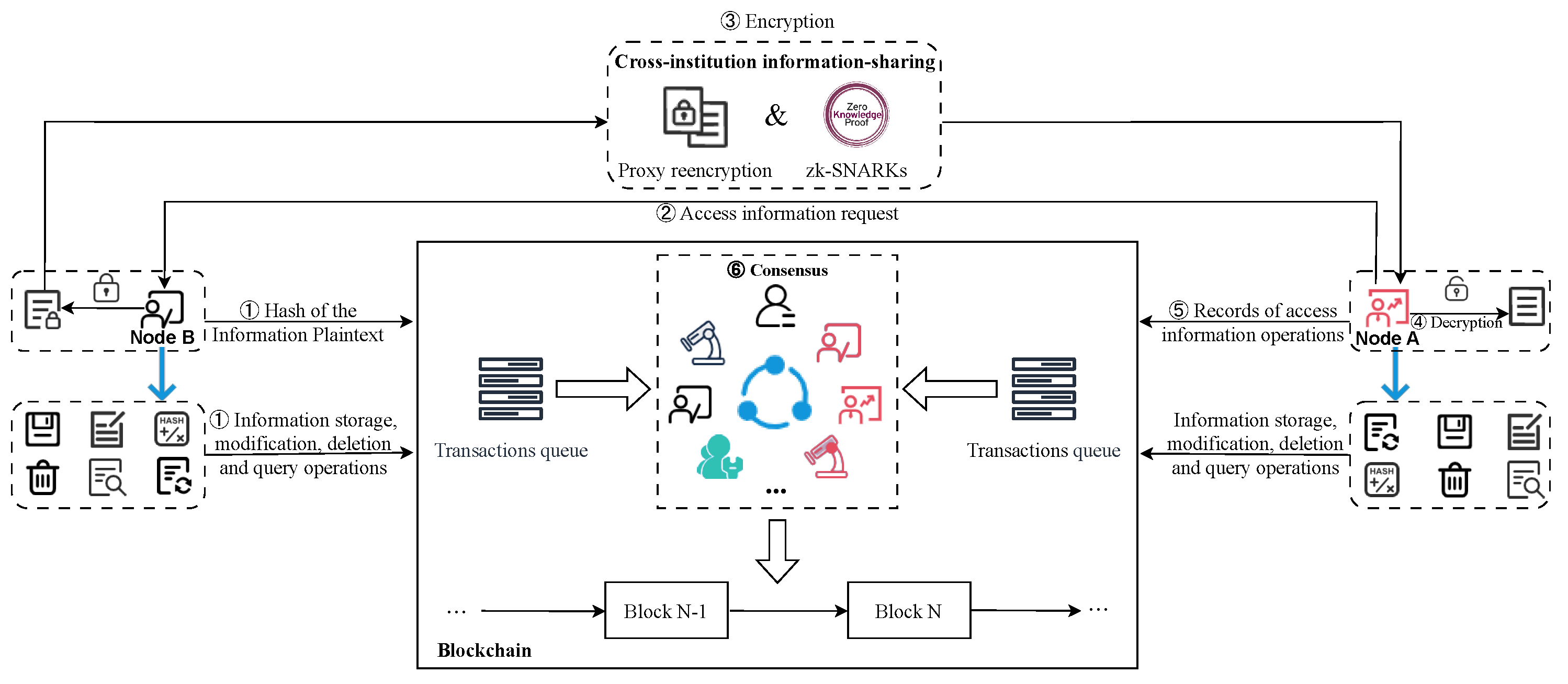
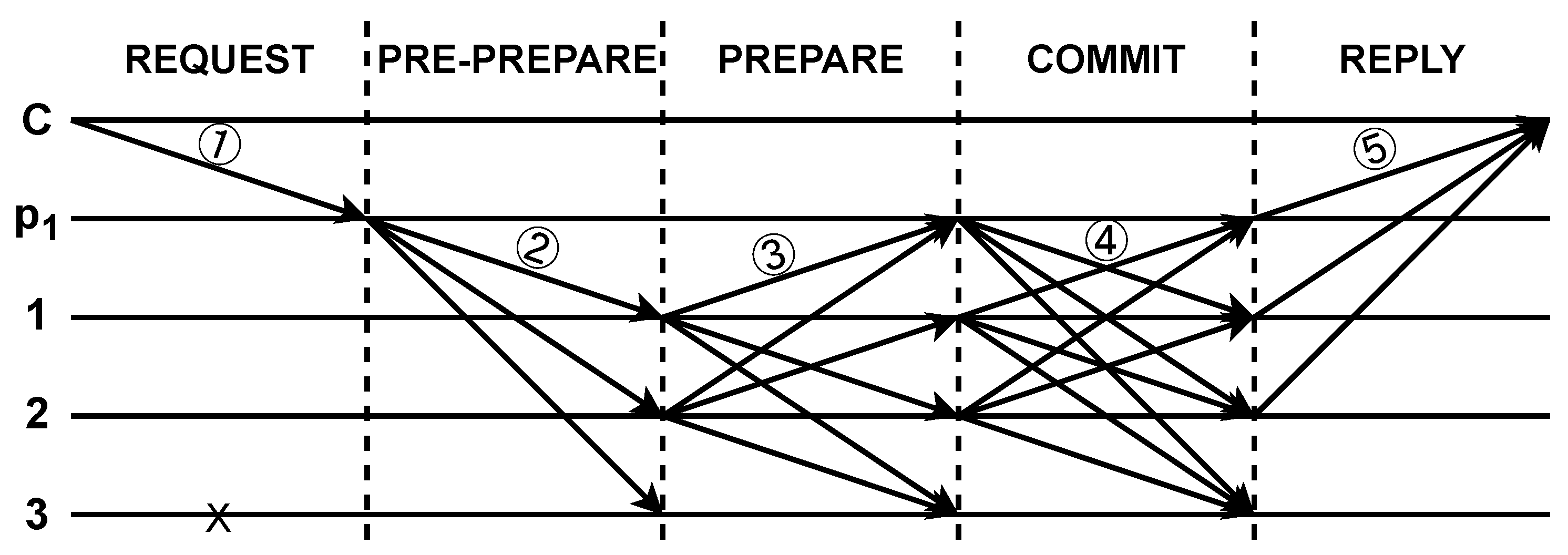
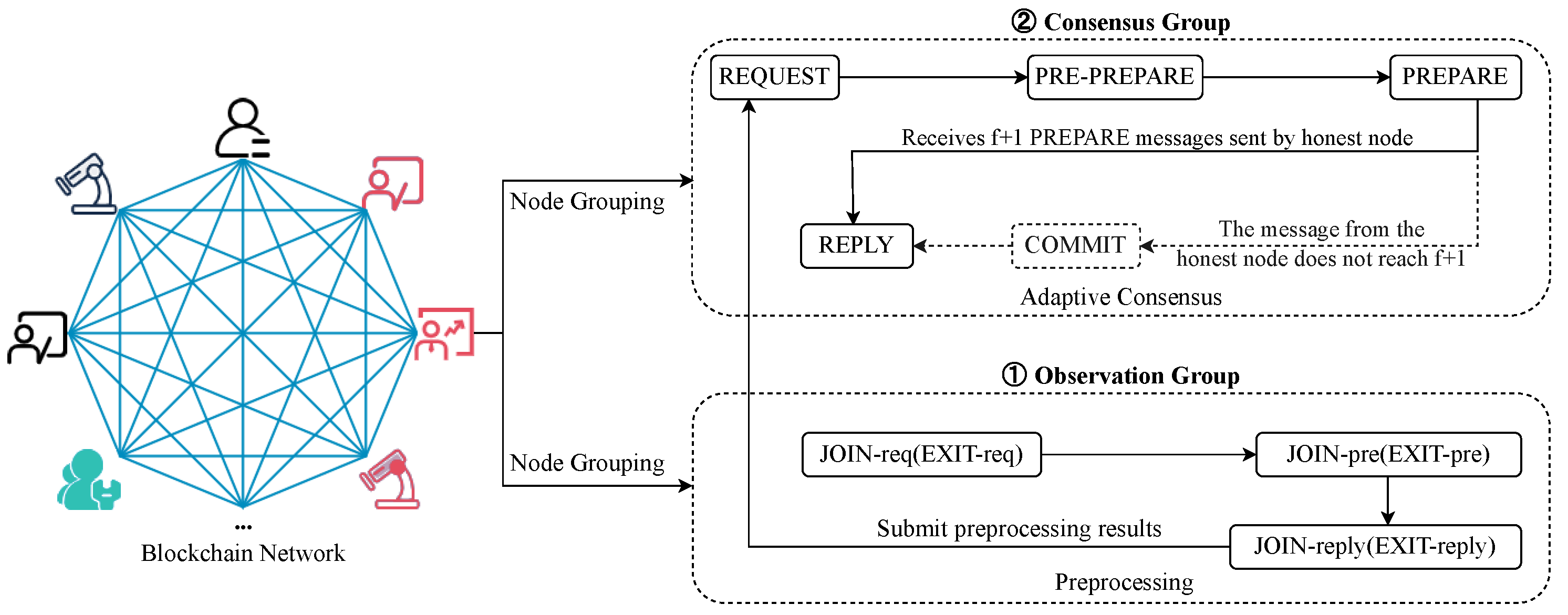
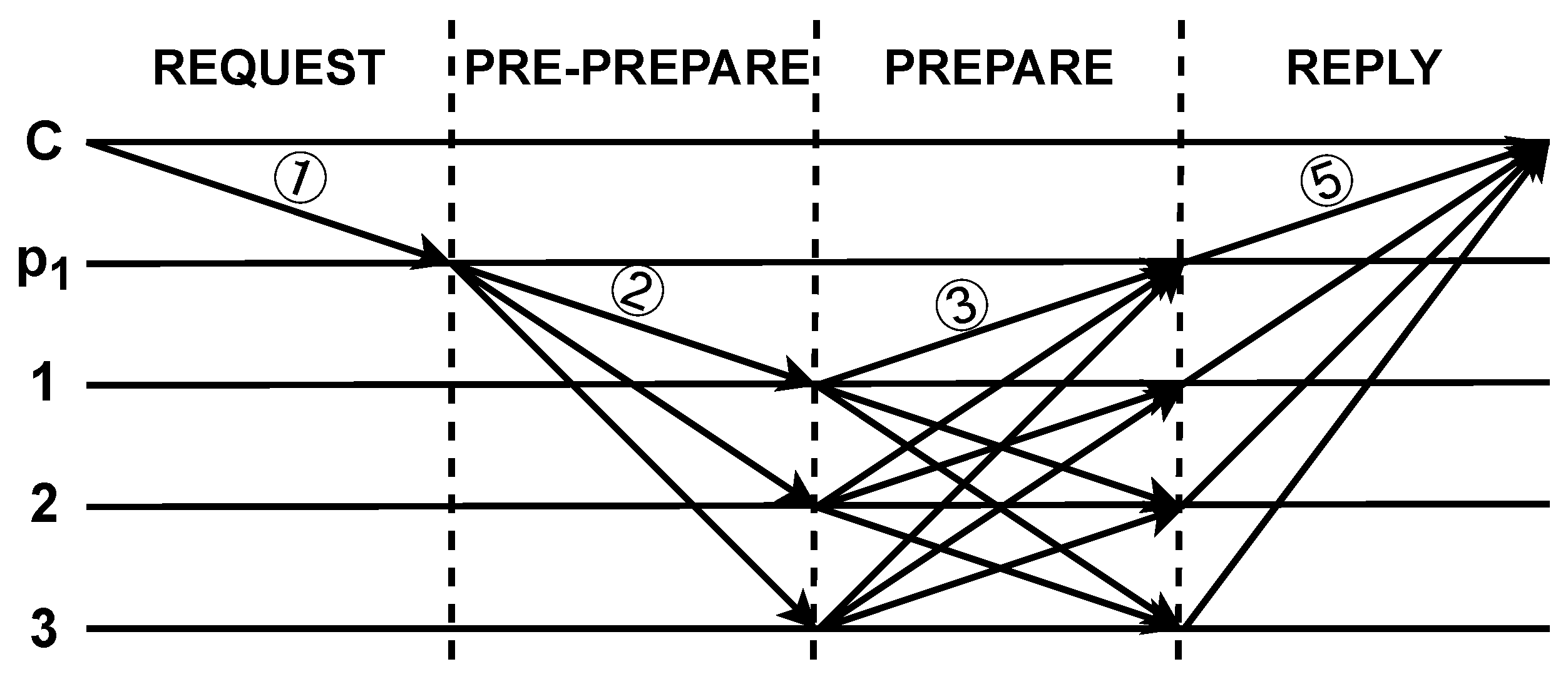

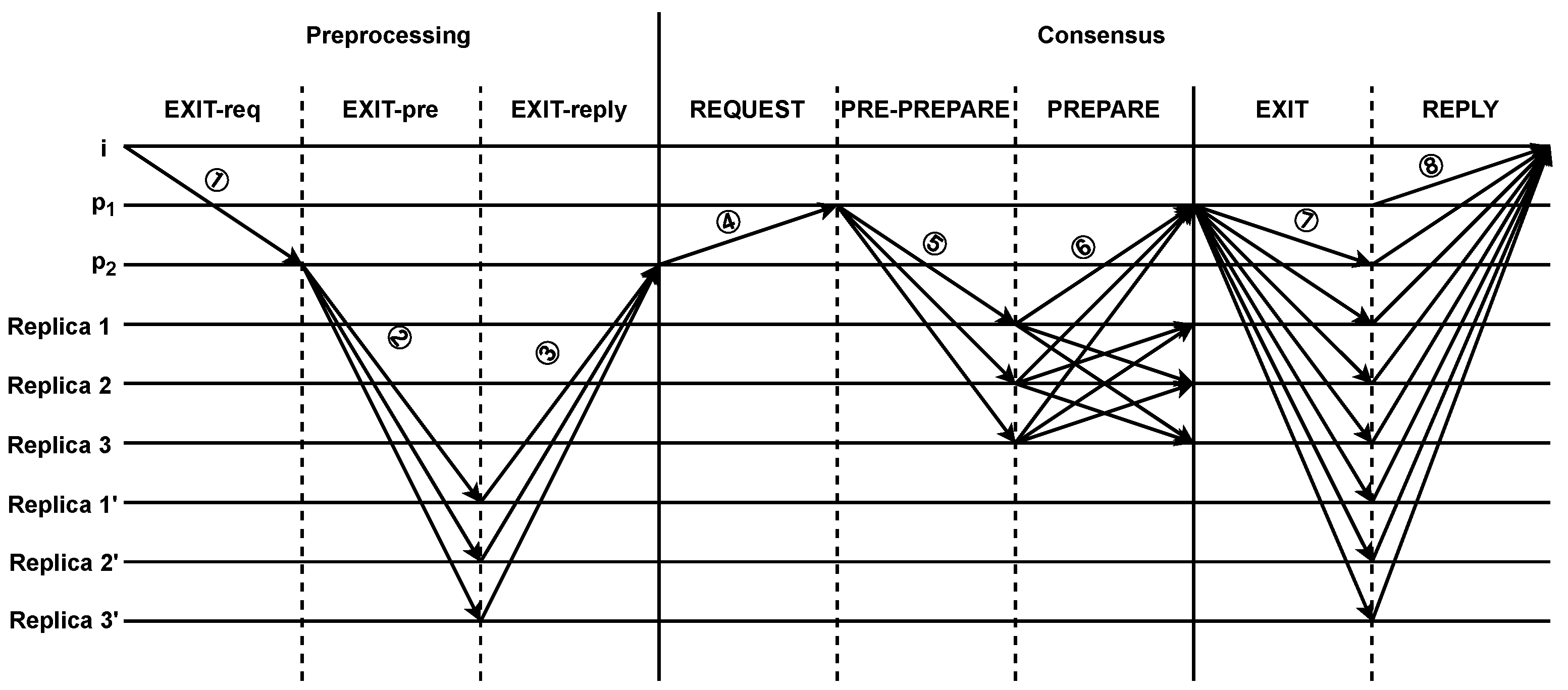
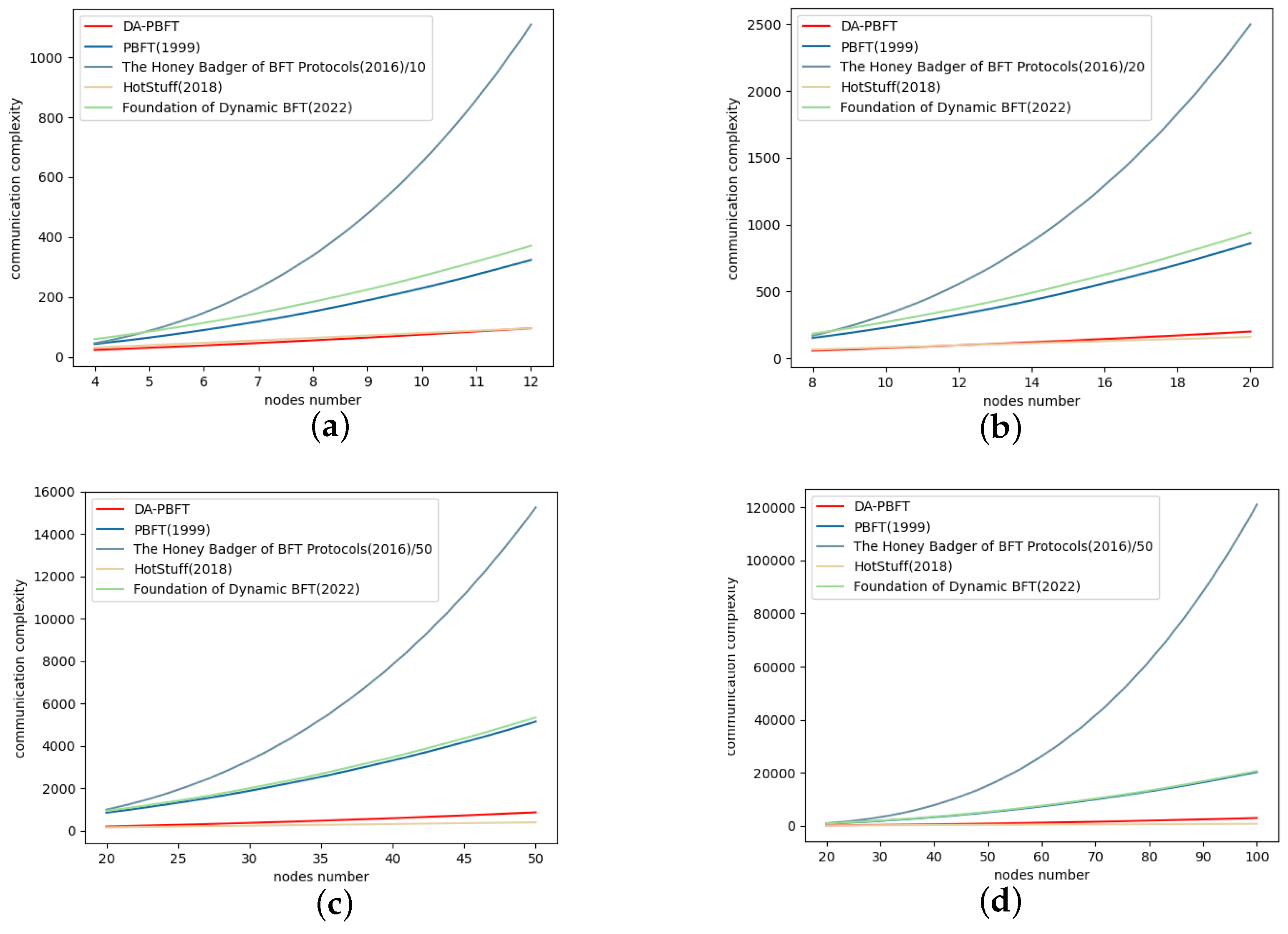
| Nations | Descriptions |
|---|---|
| n | n is the number of the network blockchain |
| f | f is the number of faulty nodes |
| is the number of consensus nodes | |
| is the number of observation nodes | |
| Primary node of the consensus group | |
| Primary node of the observation group | |
| i | a new node’s ID |
| j | a replica |
| pk | pk is the public key |
| is the signature of node i | |
| v | v is the current view number |
| m | m is the message to transmit |
| s | s is the message sequence number |
| d | d is the message m digest |
| |m| | |m| is the size of the client request message |
| C | C is the stable checkpoint |
| DA-PBFT | PBFT (1999) [14] | The Honey Badger of BFT Protocols (2016) [15] | Hotstuff (2018) [16] | Foundation of Dynamic BFT (2022) [17] | |
|---|---|---|---|---|---|
| Deployment Scenario | Consortium blockchain | Consortium blockchain | Consortium blockchain | Consortium blockchain | – |
| Msg Cplx. | 8n | ||||
| Comm Cplx. | |||||
| Fault Tolerant |
Disclaimer/Publisher’s Note: The statements, opinions and data contained in all publications are solely those of the individual author(s) and contributor(s) and not of MDPI and/or the editor(s). MDPI and/or the editor(s) disclaim responsibility for any injury to people or property resulting from any ideas, methods, instructions or products referred to in the content. |
© 2023 by the authors. Licensee MDPI, Basel, Switzerland. This article is an open access article distributed under the terms and conditions of the Creative Commons Attribution (CC BY) license (https://creativecommons.org/licenses/by/4.0/).
Share and Cite
Tan, B.; Chen, Y.; Zhou, Y.; Li, S.; Dong, Z. A Cross-Institution Information-Sharing Scheme Based on a Consortium Blockchain. Electronics 2023, 12, 4512. https://doi.org/10.3390/electronics12214512
Tan B, Chen Y, Zhou Y, Li S, Dong Z. A Cross-Institution Information-Sharing Scheme Based on a Consortium Blockchain. Electronics. 2023; 12(21):4512. https://doi.org/10.3390/electronics12214512
Chicago/Turabian StyleTan, Bingbing, Yanli Chen, Yonghui Zhou, Shouqing Li, and Zhicheng Dong. 2023. "A Cross-Institution Information-Sharing Scheme Based on a Consortium Blockchain" Electronics 12, no. 21: 4512. https://doi.org/10.3390/electronics12214512
APA StyleTan, B., Chen, Y., Zhou, Y., Li, S., & Dong, Z. (2023). A Cross-Institution Information-Sharing Scheme Based on a Consortium Blockchain. Electronics, 12(21), 4512. https://doi.org/10.3390/electronics12214512






